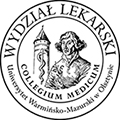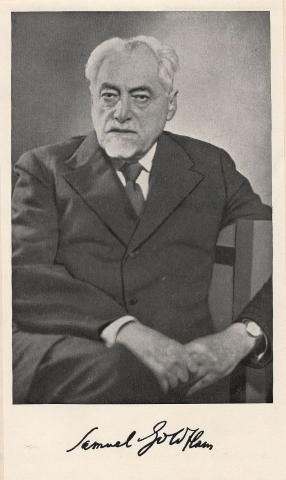Samuel Goldflam
Samuel Goldflam was born into a Jewish family on February 15, 1852 in Warsaw, which in that time was the part of Russian Imperium. His father Wolf Goldflam was a merchant. In his hometown, Goldflam graduated middle school in 1869 and he started to study at the Medical Faculty of the Imperial University of Warsaw.
Goldflam got a medical degree in 1875 and took a job in the 1st Department and Therapeutic Clinic of the Warsaw Imperial University at the Hospital of the Holy Ghost. The head of this department was the Czech surgeon parasitologist Vilem Lambl - famous from studies on the human parasite Lamblia intestinalis. Samuel Goldflam totally devoted himself to work. He spent whole days near the hospital beds or laboratory. He treated the patient not only as a subject of research and scientific observations, but also as a suffering person who should be helped. Because of his diligence, Goldflam quickly became a vital member of Lambl’s team. In the memories of Ludwik Czarkowski – one of the surgeons of the 1st Department and Therapeutic Clinic, Lambl in the end of each patient’s examination during the doctor's round used to say: “Mr Goldflam, prescribe the patient something at your own discretion”.
In that tim, he wrote the first scientific works concerning internal medicine and surgery. These were articles, “About incarcerated retroperitoneal hernia” and “Long term invagination of the jejunum caused by polyps published in 1879 and 1881, respectively in “Gazeta Lekarska”. During the work at hospital, Goldflam took a special interest in patients suffering from neurological diseases, who were hospitalized in shared rooms with other patients. It should be pointed out that in the second half of the 19th century this was a relatively new part of medicine and there were no neurological clinics in the territory of Poland.
For this reason Samuel Goldflam, fascinated by neurology, decided to go for a foreign internship. In 1882 he went to Berlin and took a job at the neurological clinic of Charite University Hospital founded and directed by Carl Friedrich Westphal - one of the most outstanding neurologists of that period. A few months later Goldflam came to Paris to take residence at the world’s first neurology clinic at Salpêtrière Hospital. This clinic was directed by Jean Martin Charcot – the first professor in the field of neurology in history, who was often called “Napoleon of neurology”. During the stay in Berlin and Paris Goldflam became acquainted not only with the most advanced methods of therapies during neurological disorders, but also with the latest trends in the neuroscience.
Samuel Goldflam came back to Warsaw in 1883 and resumed work at the department of Lambl. At the same time he opened his own private policlinic at 10 Graniczna Street, where he was taking poor patients suffering from neurological diseases without remuneration. The policlinic was made up in private Goldflam’s flat and consisted of a few very modestly furnished rooms. It should be pointed out that Goldflam created and led the policlinic using personal financial effort. Due to a high level of the Goldflam’s policlinic, a lot of surgeons wanted to work or make the internships in this hospital.
Among them were known future surgeons and scientist, including Maksymilian Biro, Jakub Lipsztat, Maksymilian Flaum, Zygmunt Bychowski and many others. In memory of them we can read that crowds of patients arrived to this facility every day. Goldflam led the policlinic for many years (from 1883 to 1922) and throughout this period he meticulously took notes and observations concerning each patient. These notes formed the basis for scientific articles from Goldflam. During the period from 1883 to 1907, Samuel Goldflam published 73 scientific articles, in which he described various aspects of diagnosis and treatment not only neurological, but also internal diseases.
In 1906 Samuel Goldflam with neurologist Ludwik Bergman and psychiatrist Adam Wizel established the Association of caregivers for Poor Jewish People with Mental Diseases. Goldflam became the first chairman of this association (until 1912). Thanks to the donation of Zofia Edelman (she gave the money from jewelry sale) the association bought the land in Otwock near Warsaw and in the years 1907-1908 built a Mental Hospital for the Jewish people “Zofiówka” (the hospital was named after the name of a founder). In the initial period “Zofiówka” consisted of 95 beds, but in 1910 and 1926 it was expanded and the number of beds was increased in the 1930s to 275. It should be underlined that the mental hospital in Otwock was at that time the biggest and most modern such hospital in Europe. Contrary to other mental hospitals of that period, patients in “Zofiówka” were not only isolated from society, but also treated using the most modern methods and brought back to social life.
Goldflam participated in creating the first polish neurological journal – “Polish Neurology”. The editorial board of this journal (apart of Goldflam) consisted of the greatest polish neurologists of that period, including Józef Babiński, Maksymilian Biro, Edward Flatau, Samuel Goldflam, Kazimierz Orzechowski, Jan Piltz and Władysław Sterling. The first edition of this journal was published in 1910. At that time Samuel Goldlfam, together with Janusz Korczak, created “The house of orphans” – the orphanage for Jewish children, which started its operation in 1912.
In 1916 Samuel Goldflam together with pediatrician Anna Braude and industrialist Maurycy Brayzel established the Friends of Children Association and became the chairmen of this association. As a part of the activity in the association Goldflam contributed to re-opening the Berson and Bauman Families’ Chlidrens’ Hospital in Warsaw, which existed from 1878, but was closed in 1923 due to financial difficulties causes by the First world war.
During the first world war (as a result of which Poland got its independence in 1918) Samuel Goldflam got involved in political activity. In the years 1916-1919 he was a member of the Municipal Board, a chairman of the Independent Jews Organization and parliamentary candidate to the Legislative Seym. Concomitantly with the social and political activity, Goldflam led scientific investigations. During the war he was one of the first to notice correspondence between malnourishment and diseases. These observations he described in the article entitled “About diseases of bones and joints against the background of inappropriate nutrition” published in 1918, where new disease under the name osteoarthropathia dysalimentaria had been described.
Samuel Goldflam was one of the founders and the first chairman (1921-1923) of Warsaw Neurological Association, as well as the co-inventor of “Warsaw Medical Journal”, published from 1924 until 1939, when the second world war broke out
In 1922 Samuel Goldflam started to work as a volunteer in the Neurological Department of the Orthodox Jewish Hospital at Czyste in Warsaw, which was directed by Goldflam’s good friend – Edward Falatau – the great neurologist and scientist. Goldflam and Flatau created in that time the Scientific Neurological Institute at the hospital at Czyste.
Despite his advancing age and greater experience in the field of neurology, Samuel Goldflam was on par with other volunteers and students of medicine. He used to say: “I’m still learning because I don’t want to be ignorant in my old age”. He also often said to younger surgeons: “There are no interesting cases. There are only patients, and each patient is interesting. Samuel Goldflam worked with great dedication. Eufemiusz Herman – a Polish neurologist who knew Glodflam personally mentioned: “When he took off the quilt from the patient’s bed, it seemed like he wanted to learn the secret of the diseases by this one movement…. and nothing escaped his attention”. In turn, Flatau called Goldflam “a diagnostician by the grace of God” and it was the greatest compliment.
Samuel Goldflam did not work only at the hospital at Czyste, but when he became interested in a particular scientific medical problem, he would walk from one Warsaw hospital to another to examine as many patients as possible. For example during the studies on reflexes, Goldflam visited many surgical departments, where examined the patients under general anesthesia, children hospitals, where he observed changes in the reflexes during ontogenesis and infectious hospitals, where he studied the influence of fever on reflexes. For this reason Goldflam and his co-workers were often called “wandering neurologists”. During examinations, Goldflam noted his observations on thousands of pieces of the paper, which he put in the pocket. When he did not have any paper, he noted his observation on the cuffs of his own shirt. In the evenings Goldflam reviewed and analyzed the notes and made the proper documentation of his studies.
Samuel Goldflam worked in this way and published scientific articles for the rest of his life. He was fully devoted to his patients and he did not start a family. He died in Otwock on August 26, 1932 at the age of 80 because of a mediastinal tumor and was buried at the Jewish Cemetery on Okopowa Str. in Warsaw. His dying wish was that people attending his funeral do not buy wreaths or flowers, but give donations to the pathological Institute of the hospital at Czyste. The merits of Goldflam have been greatly appreciated, which has found expression in the inscription on his tombstone: He devoted his life to science to ease the destiny of fellow men”.
It should be pointed out that Samuel Goldflam was not only a distinguished neurologist, but also a lover of the arts, particularly music and paintings. He was an expert of the music of Beethoven and Wagner and often visited the National Philharmonic Orchestra in Warsaw. Goldflam was also the owner of a valuable collection of paintings and sculptures. Eufemiusz Hermann - the co-worker of Goldflam said after his death that “He had the mind of a researcher and the soul of an artist. Moreover Goldflam helped artists and writers. For example he helped the pianist Artur Rubbinstein with his career and in 1900 wrote a letter of recommendation to German neurologist Emanuel Mendel for the Polish writer Władysław Reymont - the later Nobel Prize laureate, who suffered from post-traumatic neurasthenia after a train crash.
Scientific achievements of Samuel Goldflam
Samuel Goldflam was the pioneer of the microscopic examination of the brain in Poland. He is the author of about 100 scientific publications. First of all, he was interested in the neurological diseases. He described apocamnosis - the symptom characteristic of myasthenia (sometimes determined as the Erb-Goldflam disease), which consists in the development of symptoms of muscle power exhaustion with increased physical exertion. For the first time Goldflam showed in detail clinical picture and estimated etiology of the intermittent claudication and described the symptom of pallor of the feet after active movements (Goldflam – Oehler symptom), which is characteristic for this disease. Moreover, he correctly indicated that habitual smoking is an important etiological factor of intermittent claudication.
Goldflam was also interested in Rossolimo’s reflex, which is found in patients with pyramidal tract lesions. In 1930 He showed that the neuronal center of this reflex is located in the spinal cord in neuromeres L5-S1, and the inhibitory center of the reflex is placed in the cortex of the frontal and middle gyrus of the brain. Goldflam also indicated that efferent nerves within Rossolimo’s reflex run not in the pyramidal tract, but within the extrapyramidal tracts.
Moreover, Goldflam was interested in other reflexes. He described the loss of Achilles tendon reflex during tabes dorsalis, studied on pupillary reflexes and significance of Gordon’s syndrome in diagnosis of posterior spinal sclerosis, as well as for the first time observed the weakness of tendon reflexes with simultaneously intensification of skin reflexes during diabetes.
Regardless of Carl Westphal, Goldflam described periodic paralysis and was the first to note the family history of this disease. He also studied encephalitis lethargica and its complications, especially post-inflammatory Parkinson’s disease.
A lot of the scientific works of Goldflam are related to subjects connected with internal medicine. One of the most important of Goldflam’s scientific achievements is the description of “Goldflam symptom” published in 1900. It is a medical test in which pain is elicited by percussion of the area of the back overlying the kidney (the costovertebral angle, an angle made by the vertebral column and the costal margin). The test is positive in people suffering from primeval glomerular nephritis, acute pyelonephritis, and renal colic during urolithiasis.
In turn, in 1908 Goldflam described camptodactyly and investigated the changes of this disorder within a few generations of one family, and in 1911 he published one of the first descriptions of the Jod-Basedow effect in Poland.



